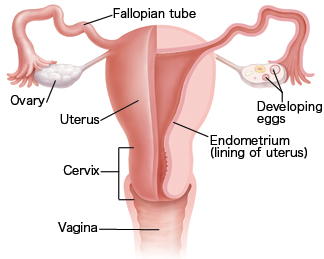Understanding the Normal Menstrual Cycle
Understanding the Normal Menstrual Cycle
Having a period (menstruation) is a normal, healthy part of being a woman. It’s also part of the menstrual cycle, a process that makes it possible for women to become pregnant. The first day of your period is the first day of your menstrual cycle.
A woman who has irregular cycles can become pregnant during bleeding. This may not be a true menstrual period.
An egg is released

The egg travels through a tube
The egg moves through the fallopian tube toward the uterus. If sperm are present in the tube, the egg may be fertilized, and pregnancy could result.
The uterine lining grows thicker
The lining of the uterus is made up of blood, tissue, and fluid. During each cycle, hormones cause the lining to thicken. This helps prepare the uterus to receive and nourish a fertilized egg.
The egg and lining are shed
If pregnancy doesn’t happen, the egg and thickened lining of the uterus are no longer needed. They are then shed through the vagina. This is called a menstrual period.
How long is each cycle?
It is normal for a cycle to take 21 to 34 days. For teenagers, the time between periods might be as much as 45 days. For adults, it will be around a month from the first day of one period to the first day of the next. That’s why you may hear women talk about a “monthly cycle,” even though cycle length can vary from one month to another, and anywhere from 3 to 5 weeks is normal. Not everyone has a 28-day cycle.
How long does a period last?
It’s normal for a period to last 2 to 7 days. Talk to your healthcare provider if your period lasts longer than 7 days for 2 cycles in a row.
Updated:
June 17, 2017
Sources:
Evaluation of the Menstrual Cycle and Timing of Ovulation. UpToDate, Physiology of the Normal Menstrual Cycle. UpToDate
Reviewed By:
Freeborn, Donna, PhD, CNM, FNP,Sacks, Daniel, MD, FACOG